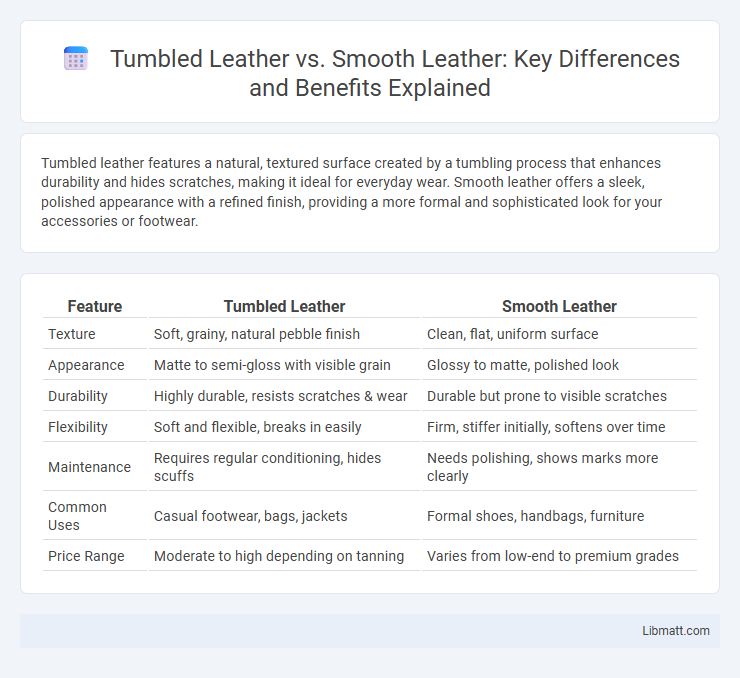Tumbled leather features a natural, textured surface created by a tumbling process that enhances durability and hides scratches, making it ideal for everyday wear. Smooth leather offers a sleek, polished appearance with a refined finish, providing a more formal and sophisticated look for your accessories or footwear.
Table of Comparison
| Feature | Tumbled Leather | Smooth Leather |
|---|---|---|
| Texture | Soft, grainy, natural pebble finish | Clean, flat, uniform surface |
| Appearance | Matte to semi-gloss with visible grain | Glossy to matte, polished look |
| Durability | Highly durable, resists scratches & wear | Durable but prone to visible scratches |
| Flexibility | Soft and flexible, breaks in easily | Firm, stiffer initially, softens over time |
| Maintenance | Requires regular conditioning, hides scuffs | Needs polishing, shows marks more clearly |
| Common Uses | Casual footwear, bags, jackets | Formal shoes, handbags, furniture |
| Price Range | Moderate to high depending on tanning | Varies from low-end to premium grades |
Introduction to Leather Types
Tumbled leather features a textured surface created by tumbling the hides in a drum, enhancing flexibility and providing a rugged, natural look ideal for durable goods. Smooth leather undergoes minimal surface treatment, resulting in a sleek, polished finish prized for its refined appearance and ease of cleaning. Both leather types originate from high-quality animal hides but differ significantly in texture, durability, and aesthetic appeal, influencing their use in fashion, furniture, and accessories.
What Is Tumbled Leather?
Tumbled leather is a type of leather that undergoes a mechanical tumbling process to create a soft, supple texture with a slightly wrinkled appearance. This process enhances the leather's natural grain, making it more flexible and resistant to scratches compared to smooth leather. Tumbled leather is often chosen for its durability and vintage look, contrasting with the sleek, polished finish of smooth leather.
What Is Smooth Leather?
Smooth leather features a polished surface achieved by sanding and buffing the hide, resulting in a sleek, uniform texture with minimal grain visibility. It is often used in high-end shoes, handbags, and upholstery due to its elegant appearance and ability to showcase rich dyes and finishes. The durability of smooth leather depends on the quality of the tanning process, with full-grain smooth leather offering superior strength and aging characteristics compared to corrected-grain variants.
Key Differences Between Tumbled and Smooth Leather
Tumbled leather features a textured, grainy surface created by tumbling the leather in a drum, enhancing its softness and flexibility compared to smooth leather's sleek, polished finish. Smooth leather offers a more uniform appearance with a glossy or matte surface, providing greater resistance to moisture and easier cleaning but less breathability. The durability of tumbled leather tends to increase with use as its texture develops character, while smooth leather retains a consistent look but may show scratches more readily.
Appearance and Texture Comparison
Tumbled leather features a distinctive, pebbled texture created through a mechanical tumbling process that enhances its grain and adds a rugged, matte finish, making it visually dynamic and tactilely soft. Smooth leather displays a sleek, uniform surface with minimal texture, resulting in a polished, glossy appearance that highlights a classic, refined aesthetic. The pronounced grain of tumbled leather provides a more casual and durable look, while smooth leather's even finish exudes elegance and is often preferred for formal leather goods.
Durability and Maintenance
Tumbled leather offers superior durability due to its textured surface that resists scratches and hides imperfections better than smooth leather. Smooth leather requires more frequent maintenance, including conditioning and careful cleaning to prevent cracking and fading over time. Your choice depends on whether you prioritize a rugged, low-maintenance material or a sleek, polished look that demands regular care.
Comfort and Flexibility
Tumbled leather offers superior comfort and flexibility due to its soft, textured surface that allows the material to easily conform to the shape of the wearer's foot. Smooth leather, while more rigid and structured, provides less immediate flexibility but can mold over time with regular use. The natural grain and pliability of tumbled leather make it a preferred choice for footwear requiring enhanced comfort and adaptability.
Common Uses in Fashion and Footwear
Tumbled leather is widely used in casual footwear and fashion accessories due to its soft texture and natural grain, offering a rugged yet stylish look ideal for boots and handbags. Smooth leather, favored for formal shoes and high-end fashion, provides a polished, sleek appearance that enhances elegance and durability. Both types cater to different style preferences, with tumbled leather emphasizing comfort and character, while smooth leather highlights sophistication and refinement.
Pros and Cons of Each Leather Type
Tumbled leather offers enhanced durability and a rich, textured appearance that hides scratches and scuffs effectively, making it ideal for everyday use, but it may require more maintenance to keep its softness. Smooth leather provides a sleek, polished look that ages gracefully with a patina, yet it is more prone to visible scratches and stains and typically feels less pliable initially. Choosing between tumbled and smooth leather depends on the desired balance between rugged aesthetics and refined elegance, as well as the intended wear and care routine.
Choosing Between Tumbled and Smooth Leather
Choosing between tumbled leather and smooth leather depends on the desired texture and durability for your product. Tumbled leather features a soft, naturally wrinkled texture that resists scratches and develops a rich patina over time, making it ideal for casual wear and rugged accessories. Smooth leather offers a sleek, polished finish that highlights a refined appearance and is easier to clean, suitable for formal goods and elegant designs.
Tumbled leather vs smooth leather Infographic

 libmatt.com
libmatt.com